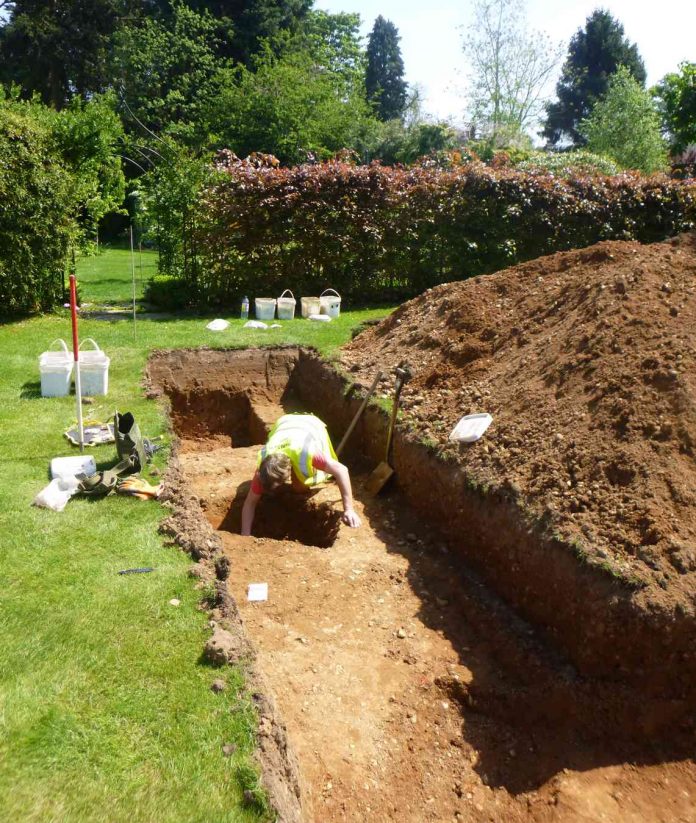On the 12th May, the Colchester Archaeological Trust conducted an evaluation at a property in St Clare Road, in the Lexden area of Colchester. The site is within an important archaeological area of the town, near to the site of the famous Iron Age ‘Lexden tumulus’* and is in the area of the extensive ‘Lexden cemetery’.
The ‘Lexden cemetery’ dates to the Late Iron Age and early Roman periods and it developed along both sides of the Roman road from Colchester to London, the line of which is now followed by the modern Lexden Road. The houses on the opposite side of St Clare Road also back on to the line of the Lexden Dyke, part of the Iron Age defensive dyke system of Camulodunum. There were areas of extra-mural settlement and cemeteries around Roman Colchester’s walled town centre.
Machine excavation of an evaluation trench was followed by hand cleaning the exposed features. Archaeologists for the Trust uncovered two Roman ditches and a Roman pit.
They also uncovered a feature which was the right shape and size for a Roman inhumation burial: Sub-rectangular, vertical-sided and flat-bottomed, it was 1.82 metres long.
This feature produced only a small amount of very degraded bone and no other finds: however, is is interpreted as a probable Roman inhumation burial.
The finds from the site consist of fragments of Roman pottery, a fragment of Roman lava quernstone which would have been imported from Germany, and some fragments of post-Roman peg-tile. Trust pottery specialist Stephen Benfield has looked at the pottery and suggests a date in the late 1st-2nd century, with the post-Roman peg-tile being intrusive. The Roman pottery includes fragments of a small jar, two large storage jars, and a large, double-handled, white ware flagon which was probably imported. The pottery fragments are residual and they suggest waste from previous domestic activity on the site.
In 2013, the Trust uncovered six Roman inhumation burials and the outlines of further possible burials during an evaluation at a property at the other end of St Clare Road, along with further Roman ditches and pits (CAT Report 745). The finds on that site included coffin nails from two of the burials, while another burial produced a fragment of Roman lava quernstone. The site also produced some fragments of post-Roman peg-tile. The burials were not excavated during that evaluation.
The evidence from the 2013 work shows that the ‘Lexden cemetery’, which was previously known as a cremation cemetery, also included inhumation burials. Now there is another probable Roman inhumation burial, also within the site of the ‘Lexden cemetery’.
All the Trust’s fieldwork reports are available online at http://cat.essex.ac.uk/ .
Trust archaeologist Ben Holloway supervised our evaluation last week.
* The site of the ‘Lexden tumulus’ is in a large garden in Fitzwalter Road. It is a scheduled ancient monument and it is a site of national archaeological importance, identified by Historic England as ‘… Iron Age [funerary] barrow and associated cemetery area …’. Colchester and Ipswich Museums, on their web-site, say that is one of the most famous Iron Age burials in Britain. See blog post about the ‘Lexden tumulus’ on this web-site at www.thecolchesterarchaeologist.co.uk/?p=10672 .
Source: Colchester Archaeology Trust


